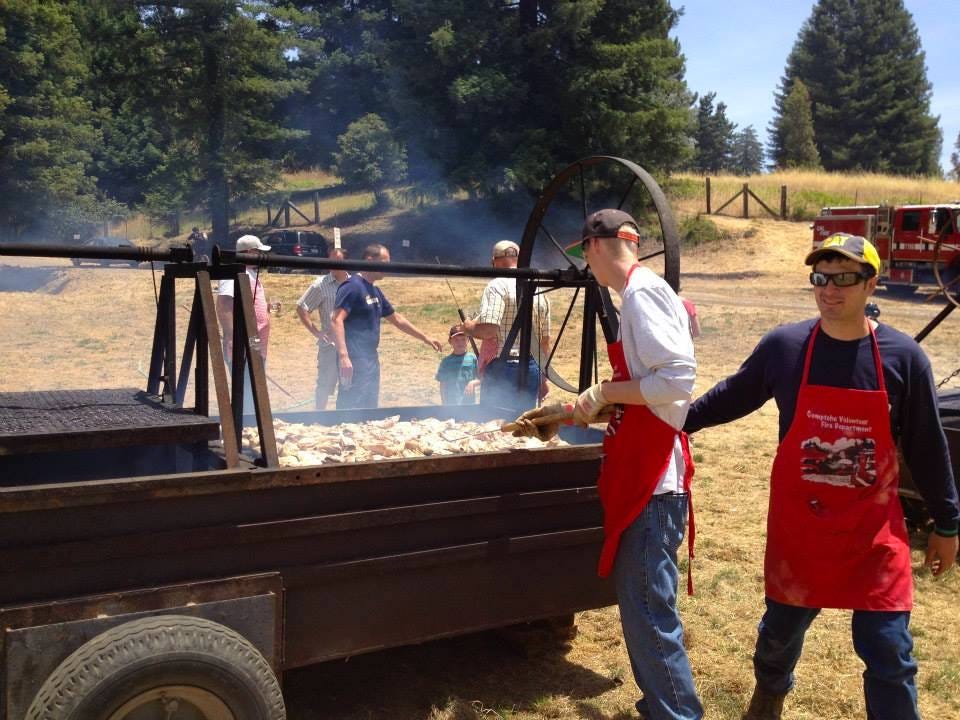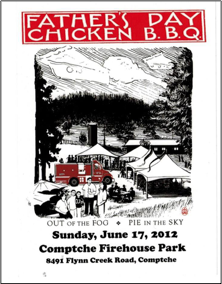
Because homes are relatively isolated throughout the district, volunteer activities are opportunities for social gatherings. Gatherings are often fundraising events for the fire department or other community need. Volunteerism brings people together through simple processes like serving flapjacks at a firehouse breakfast, maintaining fire engines, renovating the community hall, baking pies, or making a square for the annual CVFD quilt for raffle at the annual chicken dinner in June.

Volunteerism is like the warp threads, creating structure for the fabric of life in Comptche. The prime beneficiary of resident volunteerism is the Comptche Volunteer Fire Department (CVFD), serving a population that has long hoovered around 500.
The need for volunteers to support the fire department brought 1970s newcomers into the fold with old-timers. The department was relatively new, founded in 1964 after a series of devastating fires in the early 1960s, including the town mills. Lacking land and a building, the first fire trucks were parked in donated space in roadside barns. Equipment was kept centrally, in a wood chest on the Comptche store porch.
The Comptche Volunteer Fire Department was listed by all respondents in this study, newcomers and old-timers alike, as a place where they volunteered during the 1970s, and those still living there continue this tradition to this day.
The Comptche Area Fire Auxiliary (CAFA) is the fundraising branch of the CVFD, and is a close second as a recipient of volunteer labor. Starting out as the Ladies Fire Auxiliary, by the 1970s at least one man, a back-to-the-lander, joined the group so they eventually amended their moniker.
CAFA plans and organizes fundraising activities throughout the year, such as making quilt squares for the quilt raffle and other hand-sewn items for their annual fundraiser, the CVDF Father’s Day BBQ Chicken Dinner. In time, they were stitching together relationships that brought the community together on common ground they all value equally: the Comptche Volunteer Fire Department. Today the community has a permanent fire house with four engines, and an adjacent park.
Since the 1970s, The Comptche Quilters are now a separate group of volunteers who produce an annual quilt, raffled through tickets to benefit the CVFD. Every year a themed community quilt is created by volunteer crafters. They create fabric art masterpieces that consistently win ribbons at the county fair, while raising funds for the fire department.

The entire community of Comptche volunteers time and skills to the annual Father’s Day QQB Chicken Dinner. Close to the event, every able-bodied baker bakes a few pies, auxiliary members prep and cook for days ahead, and firefighters run the grill during the day for what has become a regionally celebrated, hugely successful fundraiser and social event.

Community structures in Comptche have a tradition of being maintained by volunteers. This includes physical care of buildings such as painting and repairs, as well as providing services inside those buildings. Participants in this study listed other community needs met by volunteerism in the 1970s: serving in various roles at the Comptche School, on the school board, as Grange Hall members, and serving on the Citizens Advisory Committee (CAC) during the mid-1970s.
Building Comptche’s first firehouse in the late 1980s was also listed as a volunteer activity in addition to fire department volunteerism. Volunteerism in the 1980s extended to building the town’s first church, for which locals donated tools, time, and materials including locally milled timber. These buildings are included in the next chapter about places to gather.
Volunteering is a community service. It works especially well when people are invested in their community and value equally the crucial services that are often taken for granted among larger urban populations. Volunteering also brings people together for common causes who would otherwise remain apart. It’s clear that everyone in Comptche volunteers for something, sometime during the year.
Next up:
Chapter 5: Gathering Places and Events
Resources for this post:
Spicer, Lisa Gruwell, 2012, c 2024. Finding Common Ground: When the Hippie Counterculture Immigrated to a Rural Redwood Community. Western Washington University.






